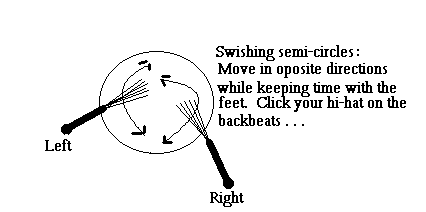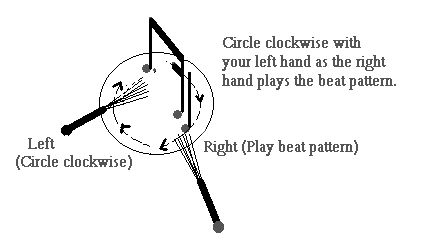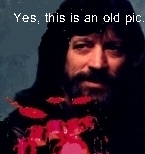


Drums: Brush Techniques:
Brushes come in all sizes and shapes, but in this lesson we are
speaking primarily of old-fashioned wire brushes used to swish, slap and scratch
rhythms at low volumes. Wire brushes were designed back in the days
before loud amplification was the norm. Drummers of old were always the loudest
member of the band and they took a lot of heat for it back then. Prior to the
1930s a GOOD drummer was to be felt and not heard! Thank goodness, all that was before my time.
Those are fightin' words, if you ask me!
Much of the music from that era was 100% acoustic. All the instruments were unamplified. This meant the drummer was always walking-on-eggshells for fear of drowning out the rest of the band. The use of wire brushes helped those old-time drummers keep their jobs.
Drummers of that era developed some rather unique and interesting techniques with their brushes. Several classic brush-stroke patterns emerged. It seems prudent that, we of this more modern era would be wise and prudent to learn what we can about those classic moves . . . Then maybe add our own touches too.
Sooner or later in every drummers career . . . there will be a gig or a situation where ANY volume is too much volume. That may be the day this little lesson will prove its value.
To begin with, I should say that brushes may be used exactly like a pair of drumsticks. There isn't a thing wrong with simply grabbing the brushes and playing as though you have a pair of sticks in your hand. You may attack the cymbals, toms, snare and hi-hat in exactly the same fashion as always. As you do . . . you'll begin to gain a special feel for the brushes. You'll quickly see that certain aspects of brushes are quite different from the sticks you may be accustomed to. The bounce and crush effects we have come to depend on when using sticks will for the most part be lost. But, after working with brushes for a little while we discover certain other special techniques that simply can not be achieved with sticks. New and different tones can be pulled from a drumset with brushes . . . by slapping, swishing and scratching. It can be a lot of fun . . . just experimenting with all the possibilities that brushes have to offer. There are some songs and situations where sticks just won't do! The only way to get certain effects is with a pair of brushes, or maybe with a brush and stick combination.
CLASSIC BRUSH STROKES:
Here are a couple of classic brush-stroke ideas you may want to master.

Here you will simply be scratching or swishing the brushes and you'll play the bass drum (downbeats) and hi-hat (upbeats). This brush-stroke sounds a lot like bacon frying in a skillet.
Think of two parentheses marks () . . . with the left brush slightly above the right brush. You are simply going to scratch those marks, one inside the other, in-time with the music. This stroke might be thought of as a brush-stroke substitute for a Swing beat or fast 4/4. Remember to kick the bass on the downbeats and chic the hi-hat (left foot) on the backbeats as you play the above pattern on the snare with both hands.
 This brush-stroke technique is a bit like patting your head and rubbing your
stomach at the same time. It may take a few minutes to get the hang of it.
With this brush-stroke, the left hand circles constantly while the right hand
plays the beat. You will be circling and scratching the snare head in a clockwise
motion with the left. The trick is to time your left-hand circles so that you can
maintain the beat (ie; 16ths, 8th triplet Blues, 8th rock, Shuffle, Swing, Waltz or any other basic beat structure).
This brush-stroke technique is a bit like patting your head and rubbing your
stomach at the same time. It may take a few minutes to get the hang of it.
With this brush-stroke, the left hand circles constantly while the right hand
plays the beat. You will be circling and scratching the snare head in a clockwise
motion with the left. The trick is to time your left-hand circles so that you can
maintain the beat (ie; 16ths, 8th triplet Blues, 8th rock, Shuffle, Swing, Waltz or any other basic beat structure).
While the left is at the 12 o'clock position, your right will be at the 6 o'clock position, then as the left swings around into the 6 o'clock position, the right-hand will glide over the top of the left-hand, to the 12 o'clock position. Also as you are doing this, you learn to 'slap' the backbeat portion of the rhythm (right-handed) with more force, thus accenting the backbeats. Don't forget the feet! All the while . . . both feet are keeping tempo on the bass and hi-hat.
The circling motion of the left-hand tends to fill up the air with a swishing sound while simultaneously helping to muffle some of the ringing tones coming from the snare drum.
THIS IS A GOOD REASON TO USE A COATED BATTER HEAD . . . I prefer using a coated-snare-batter just so my brushes will sound-off a little better. The coating is really just a fancy paint that is sprayed over an otherwise slick batter head. The off-white paint gives the appearance of real cowhide. It gives the head a rougher, more abrasive surface and is much better for achieving sizzling brush-strokes. I never use a slick snare batter for that reason. A slick batter head just won't get the effect we are looking for here.
PARTING THOUGHTS . . .(TIPS)
Drumstick manufacturers have come up with a ton of innovative new
brush-type utensils. You will find brush-stick combinations, brush-mallet
combinations, Blasticks, Hotrods and a host of other new and inviting
brush-like tools. I think they are all great. I am especially fond of the brush-mallet combination.
This tool has a mallet on one end and a brush on the other. Some very special songs require very special effects!
It may be best to purchase and experiment with all the tools you can afford!
Remember . . . the objective is to be prepared for any situation! Try to equip yourself with all the tools you can get your hands on . . . and the expertise necessary to dazzle your audience . . . no matter what the song or situation may be.
MORE . . . Drum Set Lessons.![]() Copyright Bill Powelson 1965-1996-2008-2014 @ all rights reserved.
Copyright Bill Powelson 1965-1996-2008-2014 @ all rights reserved.
![]()
![]()

![]()
Musical Time - Finite to Infinity:
Finite to Infinity:
Learn to easily jam and play music comfortably within any odd or even time signature. This material isn't currently taught in music-theory classes, yet it is simple enough for grade-school students. Discover more than 18 quintillion unique and different (modern music) song-beat structures.Discover the (lost) 500 year-old enigmatic secrets hidden within the current time-signature system. Seven short mesmerizing and easy-to-follow lessons will lead you quickly and easily towards (musical-time) guru status. You will learn to visualize (read, write or feel) the existence This should lead directly to the e-book.

This very informative little booklet will amaze you with hundreds of valuable tips and insider secrets! HOW TO: Purchase old/used drumsets for pennies and resell them for decent profits.